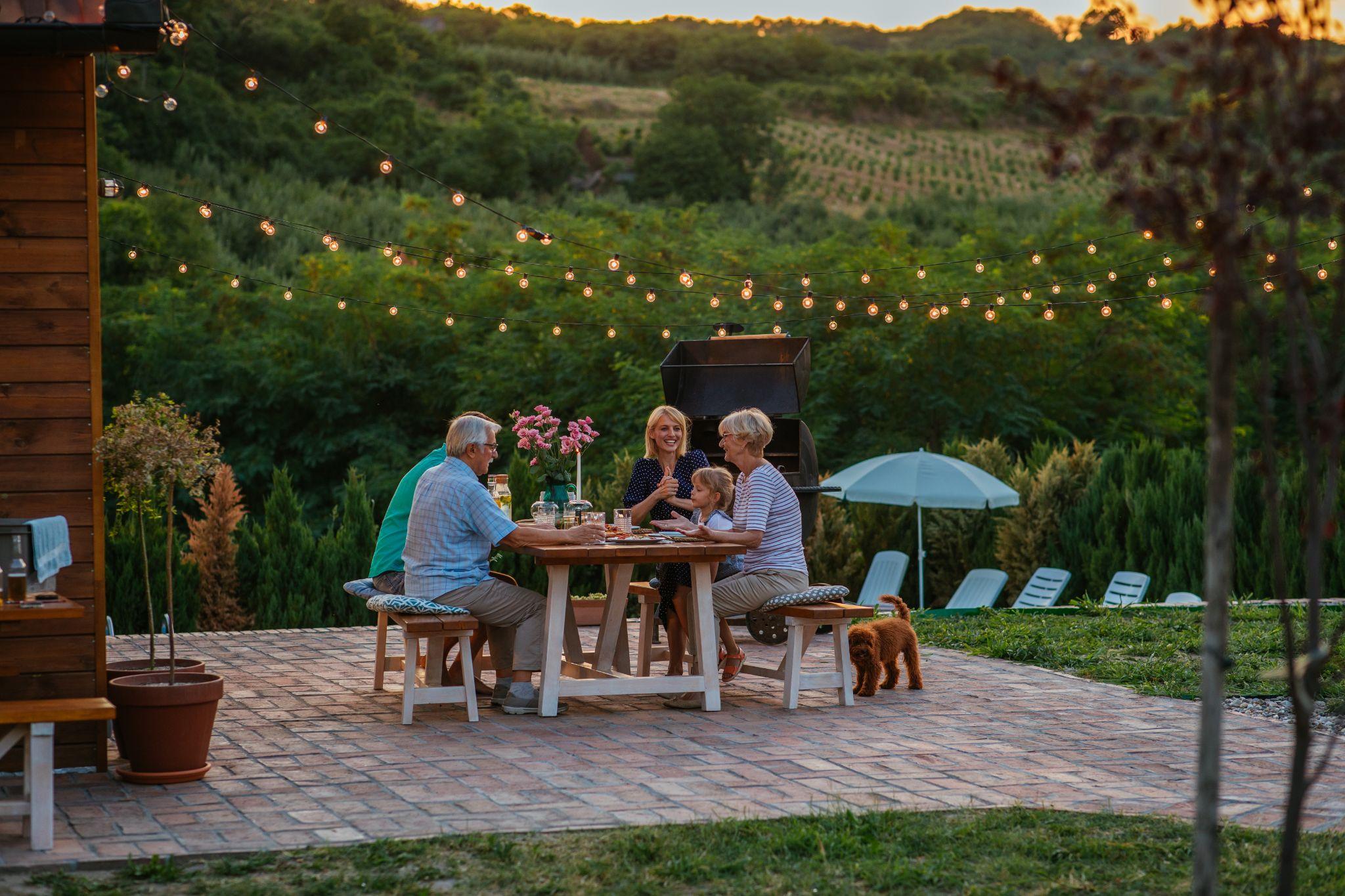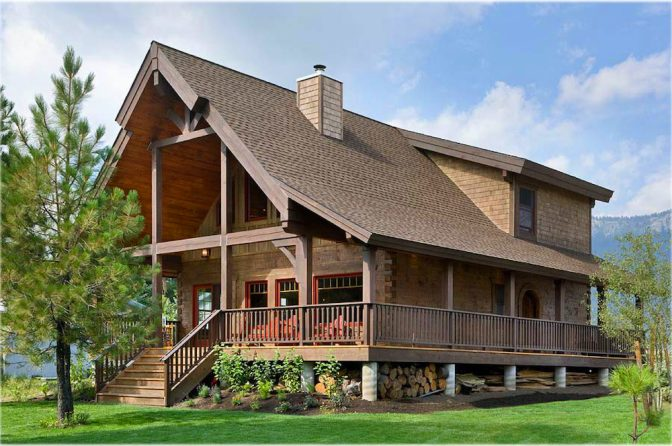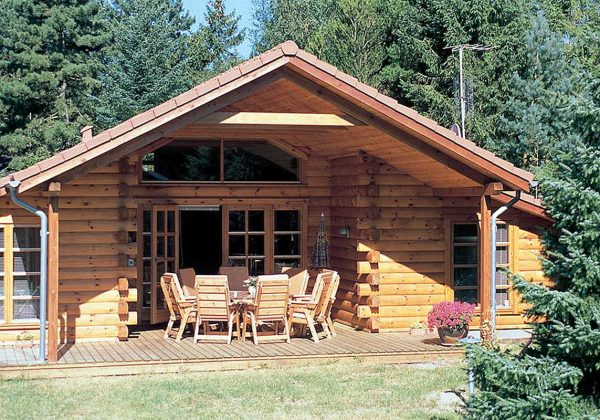Outdoor dining is one of the best ways to enjoy the natural beauty surrounding a log cabin. Whether you’re hosting a dinner party, relaxing with family, or simply enjoying a meal amidst nature, creating the perfect outdoor dining space can elevate your log cabin lifestyle.
In this guide, we’ll explore practical tips and creative ideas to help you design an outdoor dining area that blends rustic charm with modern comfort, complementing the rugged elegance of your log cabin while providing a functional, welcoming space for entertaining and relaxation.
1: Choosing the Right Location
The first step in creating the perfect alfresco log cabin dining space is choosing the right location. The best spots take advantage of natural beauty while being easily accessible from your cabin’s kitchen or main living area.
- Close Proximity to the Kitchen: Ideally, your outdoor dining space should be near the kitchen for easy access to food and drinks. This reduces the hassle of walking long distances with heavy trays and allows for smoother transitions between indoor and outdoor entertaining. If space allows, consider adding a deck or porch near the kitchen to create an inviting, practical dining area.
- Maximizing Views: One of the major benefits of log cabin living is the stunning natural surroundings. Position your outdoor dining space to take full advantage of these views. Whether it’s overlooking a forest, lake, or mountain range, placing your dining area in a spot that highlights these scenic vistas can elevate the entire experience. A deck or porch can serve as an ideal platform to enjoy those views, but even a simple patio or garden area can offer a breathtaking backdrop.
- Protection from the Elements: Consider weather factors when choosing your location. You’ll want to ensure that your dining area is protected from direct sunlight, wind, and rain. Adding a pergola, umbrella, or canopy can provide the necessary shade and shelter, making your space usable year-round.
2: Selecting Durable, Rustic Furniture
The furniture you choose for creating your outdoor living space will set the tone for the dining experience, combining both aesthetics and functionality. The goal is to select pieces that reflect the rustic charm of your log cabin while being durable enough to withstand the elements.
- Material Choices: Opt for furniture made from materials like wood, wrought iron, or natural stone to echo the rustic feel of your log cabin. Teak, cedar, and eucalyptus are excellent wood options as they are weather-resistant and age beautifully over time. Wrought iron or metal frames can be paired with rustic wood table tops for added durability.
- Comfort and Functionality: While aesthetics are important, comfort is key for creating a welcoming dining space. Choose comfortable seating with cushions that can withstand outdoor conditions, or use slipcovers for added protection. Bench seating is another great option for a more communal, rustic feel, especially if you’re hosting larger groups.
- Multi-Functional Pieces: Consider using furniture that can serve multiple purposes in your outdoor living design plans. For example, a large wooden outdoor dining table can also double as a prep station or buffet during gatherings.
3: Incorporating Natural Elements

One of the key aspects of designing an outdoor dining space for a log cabin is incorporating natural elements. The goal is to blend your dining area with the surrounding environment seamlessly.
- Stone Accents: Incorporate natural stone into your dining space, either through a stone patio, stone planters, or a stone water feature. These elements enhance the rustic feel and add texture and depth to the space while providing a tranquil atmosphere.
- Wooden Features: Embrace the natural beauty of wood in both the dining furniture and decor. Reclaimed wood can be used for tables, benches, or even outdoor shelves to store dining essentials. Consider adding a wooden pergola or trellis to a patio to provide shade while keeping the natural aesthetic intact.
- Greenery and Plants: Integrate the natural landscape by incorporating planters, hanging baskets, or vertical gardens filled with local flora. Adding greenery not only helps blend the space into its surroundings but also softens the hard lines of furniture and structures. Consider using potted herbs like basil, rosemary, or thyme, which can double as fresh ingredients for your meals.
4: Lighting for Ambiance and Functionality
Proper lighting is essential for creating a functional and inviting outdoor dining space, especially as the sun sets. The right lighting can enhance the rustic charm of your log cabin while providing a warm, welcoming ambiance.
- String Lights: Hang string lights across your dining area or under a pergola to create a cozy, intimate atmosphere. They’re a simple and affordable way to add charm and make your space feel magical at night.
- Lanterns and Candles: Rustic lanterns with LED or traditional candles are perfect for enhancing the outdoor dining atmosphere. Scatter them across the table, on nearby surfaces, or hang them from hooks or trees to create soft, ambient lighting.
- Fire Bowls and Outdoor Fireplaces: Incorporating a fire feature near your dining space not only provides warmth on cooler nights but also creates a natural focal point for the space. Whether it’s a fire bowl in the center of your seating area or an outdoor fireplace on the patio, it adds both rustic charm and functionality.
- Functional Lighting: Ensure there’s sufficient task lighting for cooking or serving, especially if you plan on dining in the evening. Low-profile, mounted wall lights or outdoor sconces that blend with the cabin’s exterior can provide ample light without detracting from the rustic design.
5: Adding Modern Comforts
While the goal is to create a rustic outdoor dining space, that doesn’t mean you have to sacrifice modern comforts. Incorporating modern elements can make the space more comfortable and functional without losing its natural charm.
- Outdoor Heating: For cooler climates or fall evenings, consider installing outdoor heaters or heated seating options to extend the usability of your dining space. Portable propane heaters, built-in patio heaters, heated benches, or even overhead infrared heaters are excellent options to keep your guests comfortable throughout the seasons.
- Outdoor Kitchen: An outdoor kitchen or built-in grill area adds convenience and modern flair to your outdoor dining space. From a simple barbecue station to a fully equipped outdoor kitchen with countertops, a sink, and storage, this feature will elevate your space, making it more practical for entertaining and cooking alfresco.
- Weather-Proof Accessories: Invest in weather-resistant cushions, throws, and outdoor rugs to add warmth and comfort to your dining area. Opt for high-quality, outdoor-grade fabrics that are resistant to moisture, mold, and fading. These accessories add a touch of modern luxury while enhancing the rustic charm of your log cabin.
Design Your Perfect Outdoor Dining Space for Your Log Cabin

If you’re designing your dream log cabin, consider incorporating a deck or porch to accommodate the perfect outdoor dining experience. A well-planned deck or covered porch not only extends your living space but also creates a functional, beautiful area to enjoy meals surrounded by nature.
eLoghomes offers customizable log home kits that make building your ideal cabin seamless. With over 200 designs to choose from, our packages include options that help you create the perfect outdoor and indoor spaces to fit your lifestyle.
Our platinum package even includes structural insulated panels (SIPs) for second-story walls, gable ends, and the roof, providing superior energy efficiency and comfort. Start planning your dream home by exploring our log cabin packages today!

